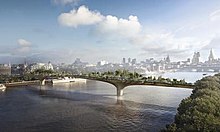Garden Bridge Project
| Garden Bridge proposal | |
|---|---|

Computer rendering of the proposed bridge, underlit at dawn and high tide, created by Arup
|
|
| Coordinates | 51°30′35″N 0°06′48″W / 51.509631°N 0.113409°WCoordinates: 51°30′35″N 0°06′48″W / 51.509631°N 0.113409°W |
| Carries | Footpath |
| Crosses | River Thames |
| Owner | None |
| Preceded by | Waterloo Bridge 200m |
| Followed by | Blackfriars Bridge 300m |
| Characteristics | |
| Material | clad concrete |
| Total length | 366 metres (1,201 ft) |
| Width | 30 metres (98 ft) (max, width varies) |
| No. of spans | three |
| History | |
| Designer | Thomas Heatherwick |
| Engineering design by | Detailed design by COWI A/S (formerly Flint & Neill) |
| Construction start | Never started |
| Construction cost | over £200 million (estimate April 2017) |
| Opened | Not open: project abandoned |
The Garden Bridge project was a private proposal for a pedestrian bridge over the River Thames in London, England. Consequent on an idea of Joanna Lumley,Thomas Heatherwick worked with Arup on a proposal by Transport for London (TfL) for a new bridge across the Thames between Waterloo and Blackfriars bridges. The proposed concrete, steel, cupronickel clad structure was intended to carry pedestrians, with no cycles or other vehicles. It was to have been located some 200 metres (660 ft) from Waterloo Bridge and 300 m (980 ft) from Blackfriars Bridge, and have included some areas of planting. The project included a commercial building, built on former green space at the southern end of the bridge. The bridge could only be funded by raising over £140 million of private money (including charitable gift aid) and £60 million of promised public money, of which £30m was from Transport for London (£20m of this to be repaid over 55 years) and £30m from the Department for Transport, adding up to projected funding of over £200m in total, In January 2017 the trustees of the prospective owner of the bridge stated that costs would "substantially exceed" an earlier revised total of £185m and in April 2017 the report by Margaret Hodge (below) concluded, on the basis of the Garden Bridge Trust's own evidence to her, that the cost would be over £200m.
If built, it was proposed that the bridge would have been open from 6am to midnight, and closed overnight, with further closures for preparation for and holding up to 12 private commercial events per year, to raise funds for its maintenance. A planning condition required annual maintenance costs to be guaranteed by a third party, and it was expected that this would be the Greater London Authority. The maintenance costs were variously estimated at between £2m and £3.5m, before allowing for repayment of loan capital and interest.
In July 2016 preparatory work for the bridge was halted and the Garden Bridge Trust put contractors on standby to allow for a financial review and because they had not cleared outstanding issues such as securing legal rights to the land on either side of the river, despite signing a contract for construction of the bridge in January 2016. In September 2016 the Mayor of London announced a formal review by Margaret Hodge of the procurement processes in relation to the bridge project and the value for money it would provide. In October 2016 the National Audit Office reported on procurement issues and perceived value for money for that part of the cost of the project which was being met by funds (£30m) from the Department for Transport. In January 2017, the accounts of the Garden Bridge Trust (the limited company behind the project) stated that it was not a going concern. In February 2017 the Charity Commission found the financial management of the trust to be satisfactory, albeit with criticisms as to the trustees' approach. The subsequent report by Margaret Hodge MP was highly critical of the plan, its procurement, its cost, the risk to public funds, and value for money.
...
Wikipedia
